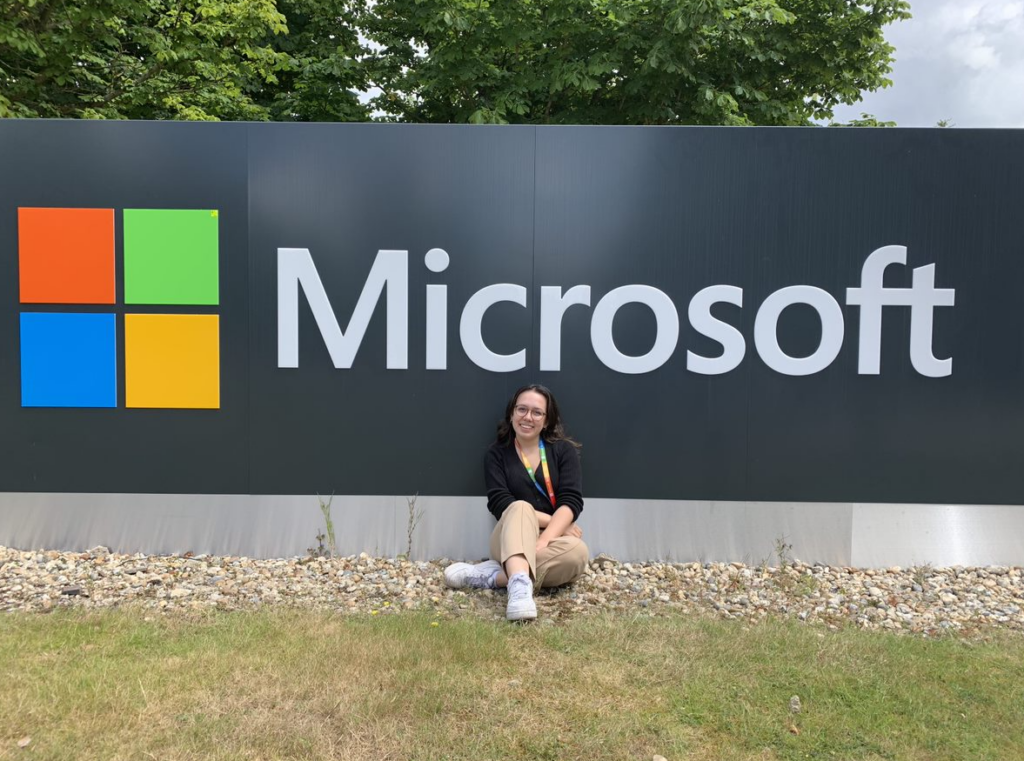Returning from a year in industry to complete their final year at Newcastle University, we interviewed Sofia Trevino, this year’s NUCATS president, about their time with Microsoft down in London. This is what they had to say:

Who did your industrial placement with?
Microsoft
What was your role?
Cloud Solution Architect Intern.
For context, a Cloud Solution Architect is “a customer-facing role, owning the overall technical relationship and strategy between the customer and Microsoft. They lead architectural design sessions, develop proof of concepts/pilots, implement projects, and deliver ongoing refinement and enhancement”.
Why did you do a placement?
Initially, it was because of an Instagram DM. At the end of my first year in 2020, I remember sitting alone in an empty student accommodation building, not knowing when or if life would ever return to normal. I have always been one for planning, but a global pandemic was not something I had prepared for. Because of this, I had to sit down and re-think how I planned to prepare myself for the real world (whatever that may look like) after university. I decided to DM a few female engineers who were offering advice to people just getting started in the tech industry. One of the engineers was @herhelloworld, a woman who was also from the US and had also decided to do her computer science degree in the UK. Her biggest piece of advice to me was to find ways to get work experience. Other engineers I wrote to gave the same advice. They said to get involved, get my name out there, and get experience. Paired with the fact that I felt as though I had lost at least a year’s worth of university experience due to COVID-19, I knew the best thing would be to try and extend my program.
When did you start applying and how many places did you apply for?
I started scoping out my options as early as August 2020. I knew if I wanted to get a placement at one of the companies I wanted, I needed to start preparing early. And it paid off, because I got the first and only placement I applied to. I know this isn’t the case for most people, and I feel extremely lucky to have been offered the role.
How was the application experience?
The application process for me began the second I decided I was going to try for a placement. I knew how competitive it would be to get a job during a pandemic, especially without any technical work experience so far, so my first focus was to learn the best techniques for applying to jobs. I attended webinars, read articles, did virtual workshops, basically anything free I could sign up for, some even in the middle of the night due to time differences.
Then I heavily researched the first company I planned to apply to, which was Microsoft. I attended a handful of their free live events to get a better idea of what they were looking for in a candidate. Through this I got even more excited about applying because I felt the company aligned with my passions. Once I did, I didn’t expect to hear back at all. It was my first placement application, and I knew that I could have improved on some parts.
Sure enough, however, I got an email back saying I was invited to an interview. Similarly, to when I first applied, I did lots of research and practiced. The first interview was just about me, my passions, and being able to articulate my reasons for wanting to work in tech and at Microsoft. A few weeks later I was invited to the assessment centre, where I was interviewed alongside about 4 other candidates. We had to do a presentation on how a particular Microsoft product could help improve the lives of a chosen business/customer, then another “personality” interview, and then a group interview, where we had to put together a presentation on where Microsoft could use their budget to innovate a field of our choice, and which technologies we’d use to do that.
Less than a week later, I received a call saying I was being offered the role by two different departments.
Overall, the application experience was long and tiresome, but not without value. Although I only went through one interview process, the skills I learned prior to and throughout have been useful to me ever since.
What, if any, help did you get from Newcastle University when applying?
I got help from the university while writing my CV. I first went through the careers service, where I sent in my CV and got back a long list of things I could change. This helped get the ball rolling for me majorly. I also got help from my personal tutor, Laura Heels, who set up a virtual CV workshop. Finally, I attended virtual events put on by the university during employability week, where I made note of what actual companies were saying they were looking for in CVs.
What work did you do over the course of your placement year?
My placement year was a unique mix of learning and doing. The role I went into was not necessarily one that you can just jump into. As a Cloud Solution Architect (CSA), you’re having to learn parts of Azure inside and out, as well as understand Microsoft’s best practices. This takes more than a year to do and gain credibility if you’re starting from scratch like me. I’m very grateful that Microsoft knew that and embraced it.
I did a lot of shadowing across the year, in many different types of teams and industries. I had the freedom to explore the work that was being done in technologies that interested me. One of my most significant experiences was getting to help deliver presentations and a hackathon to start-ups specifically centred around environmental sustainability through AI.
Another was getting to do an internal hackathon based on Azure’s serverless capabilities! I got to work with a team across the globe who were all well into their careers but were able to learn from me and I from them.
This year was full of amazing learning experiences in the technical sense. In terms of the things I delivered, those were also just as valuable, but not necessarily centred around learning a specific technology. Here are just a few of the things I got to do:
- I led philanthropic initiatives to raise money for Children in Need and Red Nose Day which built up my leadership skills
- I produced and managed three virtual events for Women in Tech which improved my organisational skills
- I worked with the education team to deliver presentations on smart city technology, and the magic of engineering and data in primary schools across London and near Reading which helped me gain better public speaking skills
How was the overall experience of doing a placement?
Overall, I feel like I had such a well-rounded experience. Not only did I get to experience the technical side of a large tech company, but also marketing, sales, leadership, and project management.
I made amazing friends, found inspirational mentors and role models, discovered more about my strengths and weaknesses, and realised where my true passions for technology are.
Sure, I may be biased but I think everyone should do a placement. With work experience being integral to securing a graduate scheme nowadays, I definitely feel like no matter where you do your placement, you will learn and grow so much in such a way that will propel you to so many amazing opportunities.
Would you like to go back to that company after your final year?
I would go back to Microsoft, yes. I resonate deeply with their core values, and I have the opportunity to do work that would really light up my soul for years to come.

